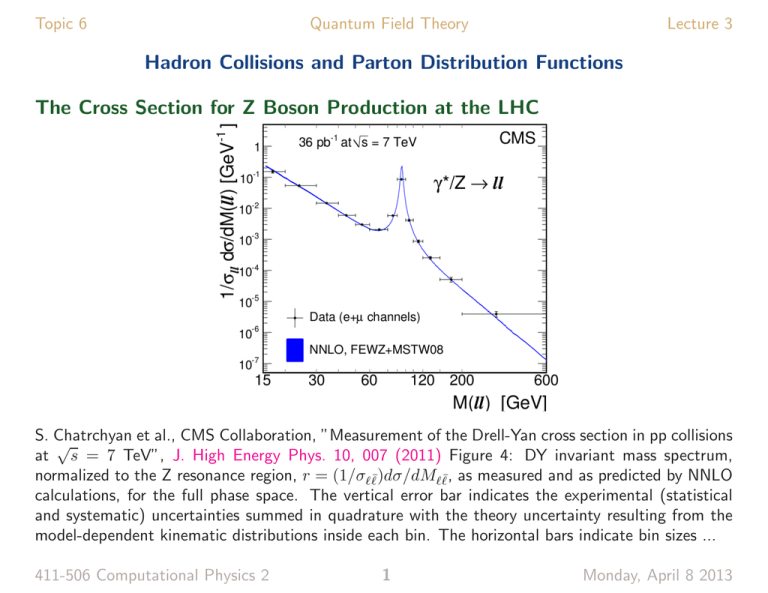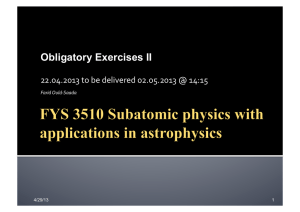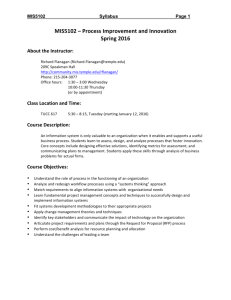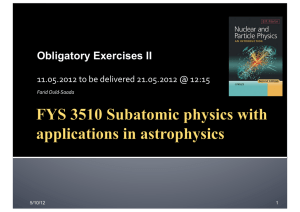Lecture 3 Slides
advertisement

Topic 6
Quantum Field Theory
Lecture 3
Hadron Collisions and Parton Distribution Functions
The Cross Section for Z Boson Production at the LHC
S. Chatrchyan
et al., CMS Collaboration, ”Measurement of the Drell-Yan cross section in pp collisions
√
at s = 7 TeV”, J. High Energy Phys. 10, 007 (2011) Figure 4: DY invariant mass spectrum,
normalized to the Z resonance region, r = (1/σ``¯)dσ/dM``¯, as measured and as predicted by NNLO
calculations, for the full phase space. The vertical error bar indicates the experimental (statistical
and systematic) uncertainties summed in quadrature with the theory uncertainty resulting from the
model-dependent kinematic distributions inside each bin. The horizontal bars indicate bin sizes ...
411-506 Computational Physics 2
1
Monday, April 8 2013
Topic 6
Quantum Field Theory
Lecture 3
The Drell-Yan Cross Section
The production of lepton pairs in hadron collision by annihilation of quarks and antiquarks is called
the Drell-Yan process.
The Drell-Yan cross section for hA + hB → (Z → ``¯ + X, where X represents the breakup products
of hadrons hA , hB and the Z decays to a pair of leptons
XZ 1
dσ a1 a2
dσ
2
h1
2 h2
dx2 dx1 fa1 (x1 , M )fa2 (x2 , M ) EQ 3 (x1 P1 , x2 P2 , M 2 ) ,
=
dΩ a ,a 0
d Q
1
2
can be computed using numerical PDFs fah (x, M 2 ) and the parton cross section qi q̄i → Z → ``¯
computed using Feynman diagrams.
The solid angle Ω = (θ` , φ` ) is the measured direction of the final state lepton, and xa is the fraction
of the hadron’s momentum carried by the parton
pa = xpb ,
S = (phA + phB )2 ,
411-506 Computational Physics 2
2
(pa1 + pa2 )2 = s = x1 x2 S ,
Monday, April 8 2013
Topic 6
Quantum Field Theory
Lecture 3
√
where S is the center of mass energy of the colliding hadrons (currently 8 TeV in proton-proton
collisions at the LHC), and s is the invariant mass (center-of-mass energy) squared of the annililating
q q̄ pair.
PDF contributions in Z production
The photon and Z boson are electrically neutral and do not change the flavor (up, down, strange, ...)
of the fermions with which they interact, or the QCD color quantum numbers in the case of quarks
and antiquarks.
The qP
q̄ pair that annihilate to produce the Z must have the same quantum numbers. The double
¯ dd,
¯ ss̄, s̄s, . . ..
sum a1 ,a2 reduces to a single sum over the different quark flavors uū, ūu, dd,
The numerical PDFs provide densities of all quark and antiquark types in the proton or antiproton.
A proton in QCD is modeled as a bound state of 3 valence quarks uud referred to a valence quarks,
as well as as virtual quark-antiquark pairs of all flavors d, u, s, c, b and even a very small density of
the very heavy t quark.
411-506 Computational Physics 2
3
Monday, April 8 2013
Topic 6
Quantum Field Theory
Lecture 3
The Parton Cross Section in Perturbation Theory
The quanta of the fields used in QCD to model the proton and other hadrons are called Partons.
There are 6 types of quark partons (u,d,s,c,t,b) each with spin 1/2 and three color eigenstates, and
the corresponding antiquarks. The analog of the photon in QED is the gluon, which is a charge
neutral spin 1 vector field like the photon, but also has 8 color eigenstates.
The basic process at the parton level
The cross sections to leading order in the electroweak coupling α are given in the Particle Data Group
summary 44 Cross-section formulae for specific processes.
44.4.1 W and Z resonant production:
Resonant production of a single Z is governed by the partial widths
√
Γ(Z → f f¯) = Nc
411-506 Computational Physics 2
2GF m3Z 2
2
2
(T3 − Qf sin θW ) + (Qf sin θw ) ,
6π
4
Monday, April 8 2013
Topic 6
Quantum Field Theory
Lecture 3
where GF is the Fermi constant for β decay, θW is the weak mixing angle, T3 is the weak isospin of
the fermion and Qf is its electric charge in units of the proton charge.
The fully differential cross section for fi f¯j → Z → fi0 f¯j 0 is given by
Ncfinal
1
s2
dσ
×
= initial ×
dΩ
Nc
256π 2 s (s − MZ2 )2 + sΓZ
h
i
2
2
02
02
2
2
02
02
× (L + R )(L + R )(1 + cos θ) + (L − R )(L − R )2 cos θ ,
where s = (pi + pj )2 = (Ei + Ej )2 − (pi + pj )2 is the invariant mass (center-of-mass energy) squared
for the process
s
L=
8GF m2Z
√
2
s
2
(T3 − sin θW Q) ,
and
Ncinitial/final =
411-506 Computational Physics 2
3
1
5
R=−
8GF m2Z
√
sin2 θW Q ,
2
for quark
.
for leptons
Monday, April 8 2013
Topic 6
Quantum Field Theory
Lecture 3
The MSTW 2008 Parton Distribution Functions
The Martin-Stirling-Thorne-Watt Parton Distribution Functions can be downloaded from
http://mstwpdf.hepforge.org/. These PDFs are very widely used in high energy physics by experimentalists and theorists. They are relatively straightforward to use.
The file mstw2008code.tar.gz contains Fortran, C++ and Mathematica code to access the data files
in mstw2008grids.tar.gz. There are three sets of grid data files: the leading order (lo) files should be
used if the theoretical cross section is known through O(αs ) in QCD perturbation theory, the nextto-leading order (nlo) files with O(αs2 ) cross sections, and the next-to-next-to-leading order (nnlo)
files with O(αs3 ) cross sections.
The Drell-Yan cross section in our example calculation does not involve the QCD coupling at all,
so the leading-order PDFs should be used. For this application we need just one grid data file
mstw2008lo.00.dat and two code files mstwpdf.cc and mstwpdf.h.
mstw.cpp
// Adapted from the MSTW2008 code file example.cc
// Needs mstwpdf.cc mstwpdf.h mstw2008lo.00.dat
// c++ mstw.cpp mstwpdf.cc
#include "mstwpdf.h"
int main()
{
string grid_file_name("mstw2008lo.00.dat");
411-506 Computational Physics 2
6
Monday, April 8 2013
Topic 6
Quantum Field Theory
Lecture 3
c_mstwpdf *pdf = new c_mstwpdf(grid_file_name.c_str());
// Specify the momentum fraction "x" and scale "q".
double x = 1e-3, q = 1e1;
cout << "x = " << x << ", q = " << q << endl;
//
//
//
//
//
//
//
//
Here the PDG notation is used for the parton flavour
(apart from the gluon has f=0, not 21):
f =
-6, -5, -4, -3, -2, -1,0,1,2,3,4,5,6
= tbar,bbar,cbar,sbar,ubar,dbar,g,d,u,s,c,b,t.
Can also get valence quarks directly:
f = 7, 8, 9,10,11,12.
= dv,uv,sv,cv,bv,tv.
Photon: f = 13.
double up,down,ubar,dbar,upv,dnv,usea,dsea,
str,sbar,chm,cbar,bot,bbar,glu,phot;
up = pdf->parton(2,x,q);
down = pdf->parton(1,x,q);
ubar = pdf->parton(-2,x,q);
dbar = pdf->parton(-1,x,q);
upv = pdf->parton(8,x,q);
dnv = pdf->parton(7,x,q);
usea = pdf->parton(-2,x,q);
411-506 Computational Physics 2
7
Monday, April 8 2013
Topic 6
Quantum Field Theory
Lecture 3
dsea = pdf->parton(-1,x,q);
str = pdf->parton(3,x,q);
sbar = pdf->parton(-3,x,q);
chm = pdf->parton(4,x,q);
cbar = pdf->parton(-4,x,q);
bot = pdf->parton(5,x,q);
bbar = pdf->parton(-5,x,q);
glu = pdf->parton(0,x,q);
phot = pdf->parton(13,x,q);
// Print out grid ranges, heavy quark masses, and alphaS values
cout <<
<<
<<
<<
"xmin =
"xmax =
"qsqmin
"qsqmax
"
"
=
=
<< pdf->xmin << ", "
<< pdf->xmax << ", "
" << pdf->qsqmin << ", "
" << pdf->qsqmax << endl;
cout << "mCharm = " << pdf->mCharm << ", "
<< "mBottom = " << pdf->mBottom << endl;
cout <<
<<
<<
<<
"alphaS(Q0) = " << pdf->alphaSQ0 << ", "
"alphaS(MZ) = " << pdf->alphaSMZ << ", "
"alphaSorder = " << pdf->alphaSorder << ", "
"alphaSnfmax = " << pdf->alphaSnfmax << endl;
411-506 Computational Physics 2
8
Monday, April 8 2013
Topic 6
Quantum Field Theory
Lecture 3
delete pdf;
return 0;
}
411-506 Computational Physics 2
9
Monday, April 8 2013



